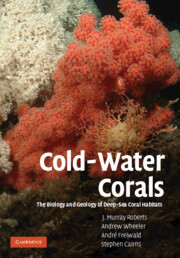6 - Palaeontology
Published online by Cambridge University Press: 23 December 2009
Summary
Richly coralliferous biostromal and biohermal limestones are widely regarded as indicators of a clear, warm, shallow-water depositional environment. If in such rocks coral organisms are associated with a rich bryozoan, brachiopod, molluscan, and echinoderm fauna, this conclusion will by most geologists be considered to approach the certainty of an observational fact. … this conclusion is not necessarily valid.
Cold- and deep-water coral banks. Curt Teichert (1958)This chapter brings a new dimension to the understanding of cold-water coral habitats by considering cold-water corals from the temporal perspective of the fossil record. We will focus on the calcified Scleractinia as their stony skeletons are widely preserved in ancient rocks. The early evolution and phylogeny of Scleractinia have been studied by comparing morphological characteristics of extant and extinct corals, their skeletal ultrastructure and, recently, by using molecular phylogenetics (see Section 2.5, p. 52). However, none of these approaches have so far provided a unified theory for the origin of the Scleractinia. The present-day coral reef ecosystem, both in shallow and deep waters, is a geologically young achievement and its fossil record is a fascinating story of extinctions and radiations mirroring dramatic changes in the Earth's climatic history. This chapter sheds light on the fossil record of the main habitat-forming cold-water coral genera Lophelia, Madrepora, Goniocorella, Oculina and Enallopsammia and it describes fossilisation processes that control the quality of preservation in this record.
Triassic dawn
What does the fossil record of the Scleractinia tell us about their ancestry?
- Type
- Chapter
- Information
- Cold-Water CoralsThe Biology and Geology of Deep-Sea Coral Habitats, pp. 175 - 209Publisher: Cambridge University PressPrint publication year: 2009

